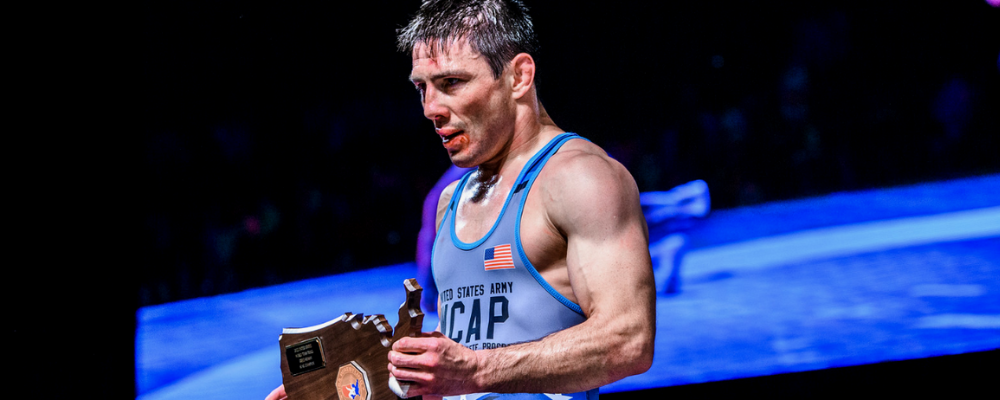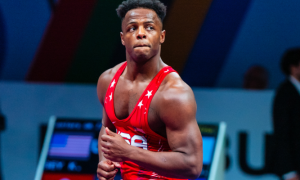The seeds of triumph were sown many moons ago, eventually producing a harvest large enough to appreciate but not large enough to last. Therefore, new seeds will now meet the soil, planted in earnest for what the Americans hope is a bountiful September reaping.
Final X: New York began at 2:00pm ET on Wednesday from the Hulu Theater in Manhattan, NY and was broadcast live on FLOWrestling.
Team USA’s 2022 Greco-Roman World Team welcomed five members onto the roster Wednesday, with all five already having experienced the highest high’s the domestic level has to offer.
At 60 kilograms, ’20 Olympian Ildar Hafizov (Army/WCAP, 5PM #2) became a three-time US World Team representative after earning a pair of hard-fought victories over chief rival/fellow Army athlete Dalton Roberts (5PM #1). Final X: New York was the third time Hafizov and Roberts comprised both halves of a Trials series. All three times they have required a third and decisive match.
Two more Olympians from Tokyo also punched their respective tickets to this year’s World Championships — Alex Sancho (67 kg, Army/WCAP, 5PM #1) and returning bronze G’Angelo Hancock (97 kg, Sunkist, world #5, 5PM #1). Sancho survived a scare in Round 1 of his series opposite Alston Nutter (Sunkist/NTS, 5PM #4) and was challenged in the proceeding bout before closing with a 5-1 decision. Hancock — who prior to Wednesday had not competed in nearly four months — defeated ’21 Junior World bronze and ’20 Olympic Trials runner-up Braxton Amos (Sunkist/Wisconsin RTC, 5PM #2) in two straight matches, even if one was different than the other. Hancock blazed to a VSU at Amos’ expense in the first round but was forced to go the distance in their next battle. On the strength of his series win last night, Hancock secured his sixth consecutive Senior Team spot at just 24 years of age.
Kamal Bey‘s (77 kg, Army/WCAP, 5PM #3) domestic re-emergence in ’22 was capped by an outstanding showing versus reigning National champ Britton Holmes (5PM #4). It was their match-up that opened the festivities, and it was Holmes who initially brought the heat. But as if automated, Bey turned on the jets in Match 1 en-route to a pin, and ultimately tied a bow around their clash via technical fall late in the second round.
Upper-weight standard-bearer Alan Vera (87 kg, NYAC, 5PM #1) is now a two-time American World Teamer thanks to his sweep of talented prospect Timothy Young (Unattached, 5PM #7). Few within Vera’s weight range in the US can meet the degree of skill and polish for which he is known. Young entered action game and prepared nonetheless — and was close on one occasion to grabbing a piece of the spotlight. Alas, it was not to be, as Vera got on a roll that opponents often find too hard to stop.
Three More
It might have been a lot to ask for Roberts and Hafizov to light up the scoreboard, particularly given the snug nature most of their previous encounters had demonstrated. Still, they obliged, whether they wanted to or not, in Match 1. Roberts used the first passivity to cinch a lift that scored four off the edge along with a 5-0 lead. But there was no comfort in that margin, as Hafizov climbed right back in the race shortly before the break. He had clasped a front headlock, risky all the more was the attempt due to the assigned official. After holding position for several moments, Hafizov scampered for a takedown and followed with a lift. Upon execution, the thing went awry with Roberts landing on top. Another scramble from Hafizov made the score 7-3. A head-wrap at the buzzer added two more onto his tally and trimmed Roberts’ advantage to a mere two points.
Passivity swung in Hafizov’s favor next. The modified high-gut was there to say hello, as well as subsequently responsible for all of the sudden changing the contest’s dynamic. With a minute remaining, Roberts had finagled high double underhooks and was navigating his lock whilst Hafizov’s back teased the boundary. But, that pop. Even now firmly into his 30’s, Hafizov’s hips retain sufficient explosiveness, which allowed for a reattacking double overhook hurl to net two more in what wound up a 11-7 decision.
Roberts’ keynote sense of urgency does not have to center around offense to prove effective. He can score in bunches, or he can grind opponents down to where that isn’t necessary. Match 2 was the latter.
His signature brand of pressure delivered, again, the opening period’s passivity/par terre. A high lock, not unlike Hafizov’s, was brandished; only on the attempted elevation, the vice spun loose and Hafizov escaped. Roberts still dictated the tempo through much of the jousting into the second frame. The passives did not flip, because a Hafizov takedown reset that imaginary timer. Needing to score not only to win but to stay alive in the series, Roberts found double underhooks as just 1:25 read the clock. He stepped hard with his outside right foot to declare the action; Hafizov bucked overhooks in response, but it was Roberts who controlled the landing for two points and the thrilling 3-2 win.
They were here in ’18, and again last fall: once more, everyone was bearing witness to a winner-take-all scenario featuring the country’s two most prolific lightweights.
And for the third straight match, Hafizov was dinged for the first-period passivity. Roberts acquired his lock but could not quite gain the feel and drive necessary for an attempt, so they were reset. An over/under position towards the end of the period ebbed more than flowed for a tense couple of ticks, putting the onus on one of them to either attack or bail. Before the 50/50 could reach an organic conclusion, Hafizov shook free and then stepped in with double underhooks. Roberts’ body autonomously, instinctively, reacted to counter but his footing betrayed him as Hafizov ambled behind for the takedown and a 2-1 lead at intermission.
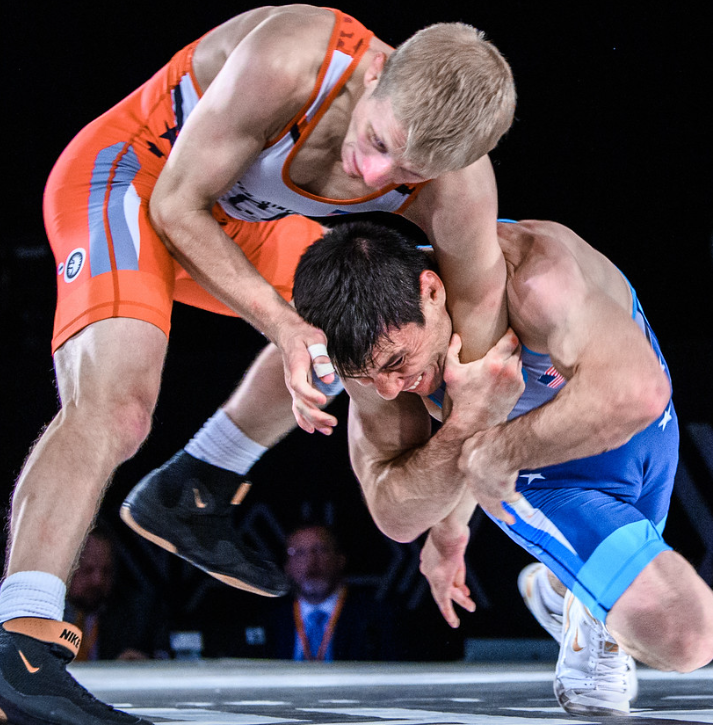
Hafizov (blue) looks for an arm throw against Roberts in Match 3 of their series on Wednesday, June 8 at Final X: New York. Hafizov won the highly-competitive series two matches to one. (Photo: Tony Rotundo)
A funhouse mirror of constant entanglement. Every little step, every handcuffed pummel, and every breakaway exchange reflected the knowledge one has of the other. Hafizov, for whom blood time was availed midway through the second period, is not the type to cocoon into a ball of sinews when holding a points advantage — but even if the opposite were true, that option was off the table. Because, Roberts was intensely digging in for a score. Hafizov had to remain engaged if for no other reason than to ward off what he had to know would be an onslaught of purposeful motion. Motion that, incidentally, later helped him tack on two enormous points.
A little over one minute hung in the air when Roberts found high double underhooks. He wasn’t hesitating with the hold. It was more that Roberts had to conduct an instantaneous cost-risk analysis whilst clutching Hafizov behind the arms. Against perhaps any other domestic opponent, this position would be seen as equally safe and offensively-effective. But Roberts understood the deal. Not brain surgery. Just a tinge too much lean? No good. Too much real estate left uncharted at the edge… Too much extension, too deep of a step… His only recourse was to gather Hafizov tightly, negotiate the space, and get his legs and hips ready to activate — all without allowing for more slack on the line than was necessary.
Unfortunately for Roberts, it still didn’t matter.
Mustering all of the oomph he had left in reserve, Hafizov arched double overhooks and landed a correct throw. The quick but completed execution brought with it a 4-1 lead. Roberts passionately pursued any and all possible avenues to score until the whistle’s screech signaled the closing to what had been their ninth World Team Trials finals match since ’18, and their tenth bout overall in that time span.
“It’s always tough, he’s a very tough opponent,” Hafizov said afterwards. “I’m very grateful having him in the room. I’m so very appreciative. It’s somebody who you know, who you wrestle all the time. It’s always tough. It is the same room, everyone sees each other all the time. He knows what I do, and I know what he does. It’s hard, it’s hard. You can’t even fake it sometimes when you have to wrestle him. He’s a very great opponent.”
Sancho Makes First World Team
Wednesday night was a momentous one for Sancho. It didn’t make the news so much. More of a footnote than a headline it had become, likely because Sancho’s earning of the Olympic Team spot last year had immediately shuffled the item into a lower-priority category in the minds of many. But with his series victory over Alston Nutter (Sunkist/NTS, 5PM #4) in New York, the Miami native had for the first time secured placement on a US Senior World Team — following five previous Trials runner-up finishes.
A furious rally in the second period of Match 1 against Nutter is what eased the weight off of his shoulders.
Nutter — who had fallen to Sancho twice over the past year in what were two very competitive bouts — carried a 2-0 advantage into the break. After the first minute of action had transpired in the second frame, he was knocked for passive. Sancho, whose prowess from par terre top sets the standard among all US light guys, wrangled his lock underneath Nutter, who was solidly defending. But there it was, the cinch and step. Sancho looked lift before going for a sort of crash gut that provided two points in addition to a 3-2 lead. Nutter’s left elbow had been torqued badly in the opposite direction during the rotation, thus requiring an injury time-out. Following a modicum of treatment from the site’s training staff, the match continued with Nutter re-starting from par terre bottom.
Another gut netted Sancho two more points — but Nutter scrambled free and immediately caught a side lift. A follow-up attempt put Sancho out of bounds and, just like that, the ’19 Junior World bronze had reclaimed the lead at 7-5. Shortly thereafter, Nutter had a lefty underhook and managed to slide-by for an attack that at first glance had appeared to register four. Upon review, the four was changed to two, but 11-7 it was with time certainly a factor for Sancho.
Facing a four-point deficit with under :30 to go, Sancho locked the body and went with a forward finish. He got the points he needed, but a challenge from Nutter’s corner prolonged the confirmation. One point for the upheld call was nothing more than window dressing in an exceptional first match that saw Sancho enter the second round ahead 1-0 in the series.
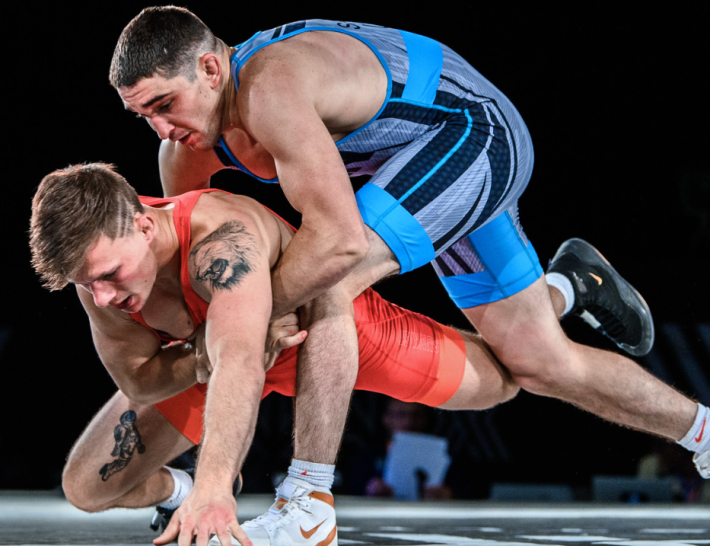
Sancho (blue) goes to work against Nutter from par terre top. Although their series at Final X: New York did not see a third and decisive match, it was as closely-contested as Hafizov/Roberts. After his series victory, Sancho said, “I’ve known Nutter since he was 16, 17-years-old coming up to Northern Michigan University. I was one of the Senior guys, he was one of the younger guys. So, I mentored him, and look at him today. He’s one of the top guys in the US.” (Photo: Tony Rotundo)
Sancho was deemed passive once Match 2 had past the preamble stage but scored on a reversal and pipelined with a gutwrench. Towards the end of the first period, Nutter went with a headlock attempt from a fleeting over/under. Sancho had it sniffed out in an instant, and assumed control for a takedown. 5-1 was the score when action resumed in the second. Sancho was visited by the passive fairy again, resulting in Nutter receiving an opportunity to make a serious dent in the proceedings, if not commandeer the lead outright. Didn’t happen. Sancho held strong in par terre, and no further scoring was realized.
“The first one (match) was cool. That’s Alston Nutter, he’s an explosive kid,” Sancho told the media pool after the series. “He’s going to go for throws. I’m a little lanky and I know how to use my hips, so I floated some of them. I got into a bodylock position with him and capitalized on it. I did not want to make this go to a third match. He’s a really good kid. I’ve known Nutter since he was 16, 17-years-old coming up to Northern Michigan University. I was one of the Senior guys, he was one of the younger guys. So, I mentored him, and look at him today. He’s one of the top guys in the US.”
Now that the little matter of Team selection is out of the way, Sancho is primed to refocus his efforts on the World Championships in September. The Tokyo Olympics offered his first taste of a Senior World-level event but the year-long postponement, he explained, might have clouded his lens. Unsurprisingly, Sancho is determined to not let that happen again.
“I think that I was so hyped, it was such a build-up two years in the making, that I wasn’t mentally prepared,” he began. “I was so excited to be there. This time around, I’ve matured and I’m calming down. I’m making sure that my mental game is there.”
Bey, Vera, & Hancock
In his first three appearances after returning to competition in early-April, Bey had performed well, dropping only a close decision to ’21 World Team member Jesse Porter (NYAC, 5PM #1) in the Bill Farrell Memorial semifinal. His next showing was the US Open, where an early default was attached to a 2-0 record. Then came the World Team Trials, which included a win at Porter’s expense. Across this limited number of matches, most of Bey’s repertoire was accessible to the human eye. But not all of it.
Final X: New York presented a more complete picture.
And it had to be that way for him to defeat Holmes, for whom the past year had imparted impressive wrestling growth.
Their series opened the card inside of the Hulu Theater at Madison Square Garden, a fitting kick-off considering their styles and the reputation of the 77-kilogram class in general. People desired to see a show, making their pairing a natural choice to break the glass on the event. Holmes came out firing in Match 1, locking a high-gut lift from par terre. Bey did reverse upon landing — and a challenge from his corner took what was a jolting 7-2 Holmes lead and whittled it down to just 3-2. When it was Bey’s chance in par terre, he lifted Holmes, who was cited for a leg foul. Another crack from top PT ushered in the second reverse lift of the match. Bey logged four with the launch and was awarded the win via fall.
Up 3-0 in the second period of Match 2, a swift, fast duck-under from Bey widened the gap but follow-up offense was stymied by Holmes. A reset, with Holmes jockeying for position and coming in hot. He needed a knockout. Time was racing off the clock when their last exchange saw Holmes quickly attempt to overhook his opponent’s arms. Bey countered in a verifiable flash with a bodylock. The points distribution arrived as time had expired, though the official on the mat called a pin. Inconsequential the methodology recorded. Back on the scene in grand fashion was Bey, who had in the process made his second-career Senior World Team after first breaking through in ’18.
Vera Goes Over Young
Young, should he stick with this whole deal, is very likely going to develop into a real-live problem for his fellow 87’s by ’24. But for his series opposite Vera to end in his favor this year, it would have needed not one, but two Buster Douglas-Mike Tyson-level upsets. Such are Vera’s over-the-moon advantages at the moment in every relevant parameter by which Greco-Roman wrestling is measured.
Although, Young didn’t just lay down and sketch out over the circumstances.
Vera swam into a bodylock early in Match 1, and when they hit the surface, Young came nice and close to carrying his hips for a step-over. Problem was, Vera never panicked. He had Young’s arm cinched and simply re-rolled. Static, apparently, on the rotation, for the ref signaled that Young was pinned a few ticks of the clock later.
In Match 2, Young did swivel over the top of a Vera gutwrench. Not an easy feat to accomplish. A reset, and the two specimens trodded back into the trenches for some busy work. Passivity on Young meant a four-point cushion for Vera. Next a side lift, but not a full-on boom, put the score at 7-1. Young defended soundly to guard against additional par terre points. Vera would find them somewhere else. Back on the feet, and the reigning World Team member bumped Young off the line twice right before the break to cap the series.
Hancock Halts Amos
There was an absence of mystery. For Amos to, somehow, sprinkle some suspense on this series, he would have to settle for making Hancock re-think transitions in and out of space, as well as chug ahead like a battering ram and commit to a breathless hand-fight — all while avoiding the big mistakes that Hancock can exploit for generating big moves. Not getting turned from bottom, another directive surely in the mind of the Junior World bronze.
Match 1 didn’t allow time for that blueprint to be followed.
After Hancock had notched one point via Amos step-out, par terre soon arrived. Try as he might, Amos could not stop a three-piece of guts, and Hancock had himself a crisp VSU.
Match 2 likewise failed to provide Amos with a spark out of the gate. The same wasn’t true for Hancock, who snagged a two-on-one and yanked Amos down from around the neck to pick up four. A dynamic, fluid adjustment from an odd position. Except, pause. As Hancock was fixing to start the merry-go-round, Amos hurriedly scrambled and escaped. He then locked behind Hancock and the subsequent deposit yielded two on his behalf.
Not long after, Hancock reeled Amos in with a textbook arm drag, his fine-tuned motion automatically putting him in position for a body attack. But the line was right there, Amos backed over it, and Hancock had to settle for a meager haul in the form of a step-out.
The score was only 5-2, to the dissatisfaction of both participants. Hancock wanted more, and Amos — fighting for his life to force a Match 3 — had to figure out a route to uncover discernible offensive chances. What didn’t help his cause was being rung up for passivity just past the 1:00 mark in the second period. As is custom, Hancock clasped, adjusted, and cranked one rotation — though on the back-end, Amos deftly switched his hips and once again found his feet.
Choppy ties in the pocket represented the go-to strategy for the duration. Amos, in hot pursuit, clawed at Hancock’s hands and raked the collar. Pushing and pulling and angling to either create open lanes, or at the least compel Hancock into overextending when exiting the kinds of mini exchanges which oft illustrate the tightness most upper-weight matches bring to bear at the Senior level. None of it was a bad idea. But also, none of it put Hancock off-balance or seemed to disrupt his steely, steady degree of patience that had long been established from over half a decade of appearing in matches just like this one. 8-2 was the summation, thus opening the door for Hancock to formalize his plans in search of a second-consecutive World medal roundabout three months from now.
After entertaining a few questions that had little or nothing to do with his actual series victory over Amos, Hancock’s mind was on more than just earning a place on the podium come September when meeting the press contingent.
“I believed, even for years before I got that medal (last October), that I was one of ‘those guys’,” Hancock said to reporters afterwards. “I believe that I’m a top competitor in the world every time I step on the mat. Even today, I believe that Braxton wrestled a World Champion. And that’s every single match I wrestle.”
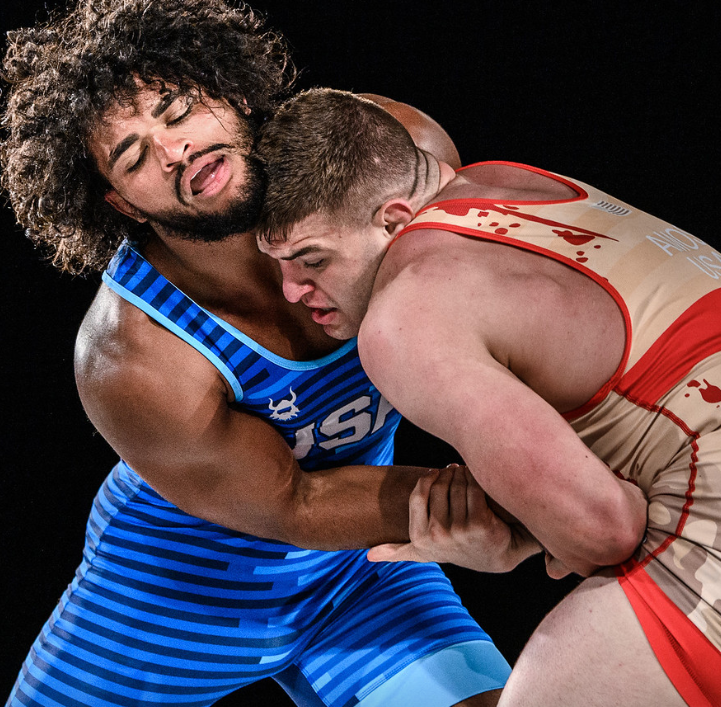
Amos (red) kept with a more physical approach in Match 2 opposite Hancock, but the ’21 World bronze’s patience and fluid pummeling, backed by an 8-2 lead, were too much for the Wisconsin Badger to overcome. (Photo: Tony Rotundo)
Notes:
- Prior to the World Team Trials finals matches was a contest for third place at 97 kilograms between Lucas Sheridan (Army/WCAP, 5PM #4) and Haydn Maley (Beaver Dam RTC, 5PM #9). Sheridan earned his fourth straight National Team spot on the strength of a 13-4 VSU.
- All five of the winners from Wednesday have appeared on at least one prior Senior World-level Team, with Vera and Hancock as the only holdovers from the ’21 Oslo roster. Hafizov and Sancho were on the ’20 Olympic Team that competed in Tokyo last August.
- Half of the 12 Greco-Roman bouts in New York were stoppages (two pins, four technical falls, VFR of 50%).
- The CSPM (average combined score) in New York among all match-ups was 10.3. In Stillwater, that number was 5.8.
- The first World Team camp for the ’22 roster will take place July 7-15 at the Olympic & Paralympic Training Center in Colorado Springs.
Final X: New York
June 8 — New York, NY
97 kg — 3rd place
Luke Sheridan (Army/WCAP) def. Haydn Maley (Beaver Dam RTC) 13-4, TF
60 kg
Ildar Hafizov (Army/WCAP) def. Dalton Roberts (Army/WCAP) 2 matches to 1
Match 1: Hafizov def. Roberts 11-7
Match 2: Roberts def. Hafizov 3-2
Match 3: Hafizov def. Roberts 4-1
67 kg
Alex Sancho (Army/WCAP) def. Alston Nutter (Sunkist/NTS) 2 matches to o
Match 1: Sancho def. Nutter 10-9
Match 2: Sancho def. Nutter 5-2
77 kg
Kamal Bey (Army/WCAP) def. Britton Holmes (Army/WCAP) 2 matches to 0
Match 1: Bey def. Holmes via fall
Match 2: Bey def. Holmes 10-0, TF
87 kg
Alan Vera (NYAC) def. Timothy Young (Unattached) 2 matches to 0
Match 1: Vera def. Young via fall
Match 2: Vera def. Young 9-1, TF
97 kg
G’Angelo Hancock (Sunkist) def. Braxton Amos (Sunkist/Wisconsin RTC) 2 matches to 0
Match 1: Hancock def. Amos 8-0, TF
Match 2: Hancock def. Amos 8-2

Listen to “5PM52: Two-Time Olympian Jim Gruenwald” on Spreaker.
Listen to “5PM51: Lining up with Tanner Farmer” on Spreaker.
Listen to “5PM50: Mr. Fantastic Benji Peak” on Spreaker.
SUBSCRIBE TO THE FIVE POINT MOVE PODCAST
iTunes | Stitcher | Spreaker | Google Play Music

Notice: Trying to get property 'term_id' of non-object in /home/fivepointwp/webapps/fivepointwp/wp-content/themes/flex-mag/functions.php on line 999

